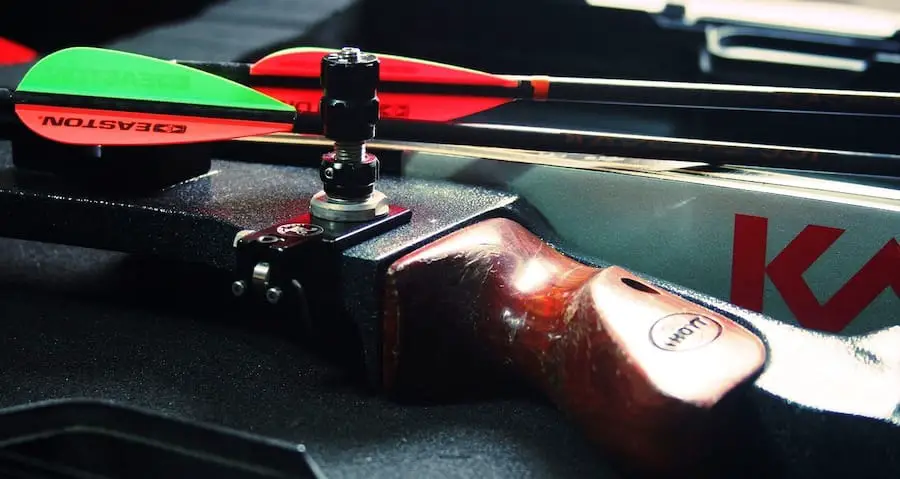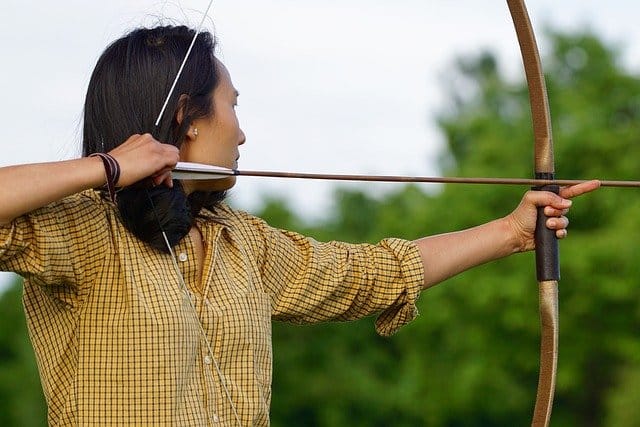Choosing the right weight for your arrow is a critical part of shooting accurately.
Heavier arrows will fly further and penetrate deeper, but they can be more difficult to control.
Lighter arrows are easier to shoot accurately, but they may not have the same stopping power as heavier arrows.
The best way to choose the right weight for your arrow is to experiment with different weights and see what works best for you. Start with a lighter weight and work your way up until you find the perfect balance of speed and accuracy. With a little trial and error, you’ll be able to find the perfect arrow weight for your shooting style.
It is important to note that the weight of an arrow is not just determined by the shaft itself, but also the specific type and weight of the attached point or broadhead. A 100-grain point or broadhead is often used as a standard when discussing arrow weights. It is also worth mentioning that adding extra accessories to an arrow, such as spin vanes or lighted nocks, can also affect its overall weight.
While there is no one “perfect” arrow weight for every situation, it is important for hunters and archers to carefully consider all factors that may influence their shooting performance and choose an appropriate arrow weight for their needs.

What should your arrow weigh when hunting for small animals?
When hunting for small animals, you want your arrow to weigh as little as possible, so you can shoot with precision and accuracy. Too much weight will slow you down and make it difficult to hit your target. Your arrow should be as light as possible while still being strong enough to take down its prey.
The length of your arrow is also important when considering what weight to use. A longer arrow will be more stable in flight, but a shorter arrow will be easier to control. You must find the right balance between these two factors to ensure that your arrow is effective.
Also, the type of bow you are using will also affect the weight of your arrows. A heavier bow will require heavier arrows, while a lighter bow can use lighter arrows. You must match the weight of your arrows to the type of bow you are using to ensure accuracy and power.
What should your arrow weigh when hunting for large animals?
When hunting for large animals, such as deer or elk, you want your arrow to be as heavy as possible. This will ensure that the arrow has enough power to penetrate the animal’s skin and kill it. A light arrow might not be strong enough to do the job and could end up wounding the animal instead of killing it.
The length of your arrow is also important when hunting for large animals. A longer arrow will provide more stability in flight, but it will also be more difficult to control. You must find the right balance between these two factors to ensure that your arrow is effective.
And as mentioned before, the type of bow you are using will affect the weight of your arrows.
What should your arrow weigh when shooting archery targets and bullseyes?
When shooting archery targets and bullseye, you want your arrow to weigh as little as possible. This will enable you to shoot with precision and accuracy. Too much weight will slow you down and make it difficult to hit your target. Your arrow should be as light as possible while still being strong enough to take down its prey.
How much does a light arrow weigh?
Lightweight arrows, typically ranging from 350-399 grains, have higher speed and are often preferred for target shooting and competition. However, they may not have enough kinetic energy to effectively take down large game animals.
How much does a standard arrow weigh?
Standard-weight arrows, ranging from 400-459 grains, strike a balance between speed and kinetic energy and are a good all-around choice for hunting and target shooting.
How much does a heavy arrow weigh?
Heavyweight arrows, weighing 460 grains or more, sacrifice some speed but offer increased penetration and knockdown power for big game hunting.
How to calculate arrow weight <- try the arrow weight calculator
What is a good weight for a hunting arrow?
When choosing a weight for a hunting arrow, hunters must strike a balance between penetration and speed. Heavier arrows will penetrate deeper, but they will also lose energy more quickly. On the other hand, lighter arrows will fly faster and be less affected by wind, but they may not have the power to reach vital organs. As a general rule, hunters should choose an arrow weight that is approximately 10% of their draw weight.
For example, if you are drawing the bow at 60 pounds, your arrow should weigh around 6 ounces. With this in mind, it is important to test various weights to see what works best for you and your weapon. By finding the right balance of weight and speed, you can ensure that your arrow will reach its target with enough force to take down your prey.
What should my total arrow weight be?
When determining your total arrow weight, there are a few factors to consider.
First, you will need to choose the right size shaft for your bow. For example, if you are shooting a compound bow with a draw weight of 40 pounds, you will likely need a lighter shaft than someone shooting a longbow with a draw weight of 70 pounds. In general, arrows should be 5-7% of your bow’s draw weight. So, for a 40-pound compound bow, your arrows should weigh between 2 and 3 ounces. In addition to the shaft, you will also need to add on the weight of the heads (field point, broadhead, etc.), fletching, and nocks.
Once you have determined the weight of each component, simply add them all together to get your total arrow weight. For example, if your shaft weighs 2 ounces, your head weighs 1 ounce, and your fletching and nocks weigh 0.5 ounces each, your total arrow weight would be 4 ounces. When choosing your arrow weight, it is important to strike a balance between penetration and kinetic energy. Too much weight can sacrifice penetration, while too little can sacrifice kinetic energy. Ultimately, the best way to find the right arrow weight for you is to experiment with different weights and see what works best for your particular setup.
Do heavier arrows fly better?
Heavier arrows tend to be more stable in flight, making them more accurate. So if you’re looking for arrows that will fly true, look for ones with a high GPI.
When it comes to arrows, there is a lot of debate about what weight is ideal. Some archers prefer lighter arrows, citing that they are easier to control. Others argue that heavier arrows fly straighter and pack more of a punch when they hit their target. So, which is the better option?
There is no clear answer, as it really depends on personal preference. Some archers find that lighter arrows are easier to control, while others find that heavier arrows provide more stability in flight. Ultimately, it is up to the individual to experiment with different weights to see what works best for them. There are many factors to consider when choosing an arrow weight, so it is important to take the time to find the perfect balance for your needs.
What happens if arrows are too heavy?
If arrows are too heavy, they will cause the bow to be less accurate. The heavier the arrow, the more force needed to shoot it. This extra force causes the bow to move slightly to the left or right when the arrow is released, making it more difficult to hit the target.
In addition, a heavy arrow will also slow down more quickly than a light arrow, making it harder to hit a moving target. As a result, it is important to choose arrows that are the right weight for your bow.
What happens if arrows are too light?
If arrows are too light, they will not have enough kinetic energy to penetrate their target. This is because the amount of kinetic energy an arrow has is directly proportional to its mass. In order for an arrow to kill an animal, it needs to be able to penetrate the animal’s hide and reach its vital organs. If the hide is too thick or the arrow is too light, the arrow will not have enough kinetic energy to penetrate the hide and will simply bounce off. As a result, hunters who use too light arrows often end up wounding their prey. In addition, lighter arrows are more likely to be blown off course by wind, making them less accurate than heavier arrows. However lighter arrows will be less time in the wind. As a result, hunters should carefully consider the weight of their arrows before heading out into the field.
Is a 400-grain arrow heavy?
A 400-grain arrow is a bit on the heavier side, but it can still be a good choice for some hunters. Those who are looking for maximum penetration and aren’t concerned about accuracy may find that a 400-grain arrow is the perfect option.
How many grains is a 400-spine arrow?
A typical 400-spine arrow will weigh between 6.5 and 7.5 grains per inch. This means that a 27″ arrow will weigh between 175 and 210 grains, while a 30″ arrow will weigh between 195 and 225 grains. The spine of an arrow is a measure of its stiffness, and the grains per inch is a measure of its weight. A heavier arrow will generally have a higher spine, while a lighter arrow will have a lower spine. The reason for this is that the heavier the arrow, the more force is required to bend it. As a result, a higher spine arrow will be less likely to flex or break when shot. A lighter arrow, on the other hand, will be easier to shoot but may not be as durable. When choosing an arrow, it is important to consider both the weight and the spine in order to find the perfect balance for your bow.
Is a 350-grain arrow good for deer hunting?
The answer to this question depends on a number of factors, including the type of bow being used and the size of the deer. For example, a 350-grain arrow fired from a compound bow with a draw weight of 70 pounds will have more kinetic energy than the same arrow fired from a recurve bow with a draw weight of 50 pounds. This extra kinetic energy can be beneficial for hunting larger game animals such as deer, as it increases the chances of penetration and a clean kill. However, it is important to remember that too much kinetic energy can also cause damage to the meat, so it is important to find the right balance for the particular animal being hunted. In general, a 350-grain arrow is a good choice for deer hunting, but it is always best to consult with an experienced hunter or archery shop before making your final decision.
What parts on an arrow can you change the weight on?
When it comes to weight, there are a few different parts of the arrow that you can alter in order to change the speed and weight.
The first part is the broadhead, which is the part of the arrow that does the actual piercing. Broadheads come in a variety of sizes and weights, so you can experiment with different ones to see what works best for you.
Another part of the arrow that affects weight is the fletching, which is the feathers that stabilize the arrow in flight.
The nock can also be changed. Arrow nocks come in a variety of sizes and weights, but they typically weigh between 2 and 5 grams. As a result, they have very little impact on the overall weight or balance of an arrow. In addition, arrow nocks are designed to be easily replaced if they become damaged or lost. As such, they are not a critical component of an arrow and can be readily replaced without affecting its performance.
The length and the type of the shaft also affect the weight. A longer shaft means more weight, while a shorter shaft means less weight. So, if you’re looking to make your arrow lighter, you can try shortening the shaft. Or you can change the material of the shaft. Carbon arrow shafts are lighter than aluminum arrows. Given that, they have the same diameter and arrow length.
Most arrow tips weigh between 10 and 20 grains. The weight of an arrow tip is important for two reasons: balance and penetration. A heavier arrow tip will significantly change the balance of the arrow, making it more difficult to aim. Additionally, a heavier arrow tip will penetrate deeper into targets, making it ideal for hunting. However, it is worth noting that a heavier arrow tip will also result in less kinetic energy, making it less effective for target practice. As a result, many archers choose to use lighter arrow tips for practice and reserve heavier arrow tips for hunting purposes.


